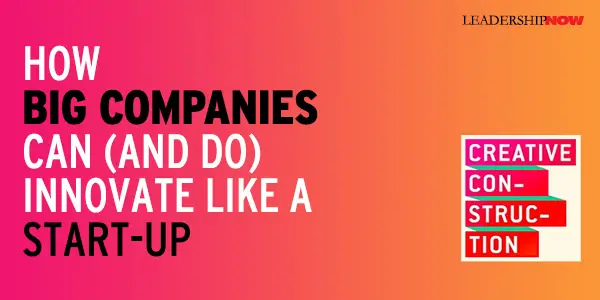 |
 |
03.18.19

How Big Companies Can (and do) Innovate Like a Start-Up
THE INNOVATION WE PRIZE at successful start-ups is a mindset that is brought into the start-up and not necessarily the inherent quality of every start-up. Innovation isn’t something that just happens; we create the conditions for it. Big organizations can innovate like small start-ups. In Creative Construction, Gary Pisano says that when big organizations fail to innovate, the root cause is often related to “management practice and leadership than with organizational scale per se.” While organizational size complicates innovation, “scale if properly exploited could actually be an advantage, not a liability, for innovation.” But here’s the thing: Simply breaking up a large organization into smaller units or creating autonomous teams is not sufficient to replicate a start-up culture. Urgency, accountability, and risk tolerance in start-ups are mindsets. Re-creating these mindsets inside an established company is challenging because they result partly from the unique pressures and circumstances under which start-ups operate. Creative Construction is the process of sustaining and rejuvenating an existing organization’s innovative capabilities. “Creative construction requires a delicate balance of exploiting existing resources and capabilities without becoming imprisoned by them.” Creative construction requires three essential leadership tasks: creating an innovation strategy, designing an innovation system, and building an innovation culture. Pisano carefully details how companies should do each of them. Creating an Innovation Strategy A good strategy helps a company clarify the tradeoffs that will be needed to make between short-term improvements and long-term opportunities. It also aligns a company around common priorities. An innovation strategy has to be based on what kind of innovation is needed. He describes four types: Routine, Disruptive, Architectural, and Radical. Each requires a different system in place to execute on it. Whatever the innovation, “the right way to judge the merits of any innovation (and innovation strategy) is value created and captured.” When faced with a potential threat of technology or business model disruption, you need to consider two things. First is the nature of the threat. How certain are you of the threat and is it imminent or distant? And second, what is the impact on your profitability. If you adopt the technology or business model, will you achieve a reasonable profit? He produced a chart that helps to clarify these opportunities.
For example, if the threat is highly likely (imminent) and the profits from it are at least as good as your current business, then jumping on the opportunity is the thing to do. He calls this scenario A New Day is Dawning. On the other hand, is the threat is imminent, but you can’t respond profitably, then The Party is Ending. In this case, you can either find new markets where you might compete or try to defend and extend the ultimate conclusion to give you time to create a better ending. The other possibilities are Intriguing Possibilities and Dark Clouds on the Horizon. In these scenarios, you are not sure the threat will materialize or if it will disrupt your profitability. “The best strategy when facing high degrees of uncertainty is to hedge and build options for the future.” Too often, innovation leadership Is posed as a test of “guts”—are you willing to make the big bets? Such “all-in” bets make for great business headlines, but they are actually pretty foolish if you face high levels of uncertainty. Making smaller bets, experimenting, learning, and adapting are survival-enhancing behaviors in highly uncertain environments. Designing the Innovation System The next essential leadership task he covers is designing a system that will give you the capability to execute on the type of innovation you need. One size does not fit all. There is no best practice. What works for Apple and Google may not work for you. Designing innovation systems begins with getting out and discovering novel problems and solutions. “Innovation in general, and the search for innovative ideas particular is an intensely human activity. What we see, what we experience, whom we listen to, whom we speak to, and whom we observe all shape our perceptions about problems worth solving and solutions worth pursuing.” Pisano says to find, develop and retain the synthesizers in your organization. Those people who are good at seeing connections across fields. Which projects should you work on and which should you kill? Build learning into your system as part of the selection process. Innovation means tradeoffs. “Every dollar that goes into exploring a new space means one less dollar for making an important refinement to a new product.” Use analytics to drive questions not answers. Building the Culture We have all heard the characteristics of an innovative culture. But leaders are not always quick to embrace them. Perhaps though, these characteristics alone are not enough. Pisano modifies each this way: Tolerance for Failure but No Tolerance for Incompetence
Willingness to Experiment but Highly Disciplined Psychologically Safe but Brutally Candid Collaborative but Individually Accountable Flat but with Strong Leadership

Posted by Michael McKinney at 08:10 PM
|
BUILD YOUR KNOWLEDGE
 

How to Do Your Start-Up Right STRAIGHT TALK FOR START-UPS 
Grow Your Leadership Skills NEW AND UPCOMING LEADERSHIP BOOKS 
Leadership Minute BITE-SIZE CONCEPTS YOU CAN CHEW ON 
Classic Leadership Books BOOKS TO READ BEFORE YOU LEAD |